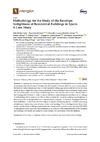Identificador persistente para citar o vincular este elemento:
https://accedacris.ulpgc.es/jspui/handle/10553/41487
| Campo DC | Valor | idioma |
|---|---|---|
| dc.contributor.author | Feijó Muñoz, Jesús | en_US |
| dc.contributor.author | Poza Casado, Irene | en_US |
| dc.contributor.author | González Lezcano, Roberto Alonso | en_US |
| dc.contributor.author | Pardal, Cristina | en_US |
| dc.contributor.author | Echarri, Víctor | en_US |
| dc.contributor.author | Assiego De Larriva, Rafael | en_US |
| dc.contributor.author | Fernández Agüera, Jesica | en_US |
| dc.contributor.author | Dios Viéitez, María Jesús, | en_US |
| dc.contributor.author | Del Campo Díaz, Víctor José | en_US |
| dc.contributor.author | Montesdeoca Calderín, Manuel | en_US |
| dc.contributor.author | Padilla Marcos, Miguel Ángel | en_US |
| dc.contributor.author | Meiss, Alberto | en_US |
| dc.date.accessioned | 2018-07-06T08:35:11Z | - |
| dc.date.available | 2018-07-06T08:35:11Z | - |
| dc.date.issued | 2018 | en_US |
| dc.identifier.issn | 1996-1073 | en_US |
| dc.identifier.uri | https://accedacris.ulpgc.es/handle/10553/41487 | - |
| dc.description.abstract | Air leakage and its impact on the energy performance of dwellings has been broadly studied in countries with cold climates in Europe, US, and Canada. However, there is a lack of knowledge in this field in Mediterranean countries. Current Spanish building regulations establish ventilation rates based on ideal airtight envelopes, causing problems of over-ventilation and substantial energy losses. The aim of this paper is to develop a methodology that allows the characterization of the envelope of the housing stock in Spain in order to adjust ventilation rates taking into consideration air leakage. A methodology that is easily applicable to other countries that consider studying the airtightness of the envelope and its energetic behaviour improvement is proposed. A statistical sampling method has been established to determine the dwellings to be tested, considering relevant variables concerning airtightness: climate zone, year of construction, and typology. The air leakage rate is determined using a standardized building pressurization technique according to European Standard EN 13829. A representative case study has been presented as an example of the implementation of the designed methodology and results are compared to preliminary values obtained from the database. | en_US |
| dc.language | eng | en_US |
| dc.relation.ispartof | Energies (Basel) | en_US |
| dc.source | Energies (Basel) [ISSN 1996-1073], v. 11 (4), 704, (Abril 2018) | en_US |
| dc.subject | 6201 Arquitectura | en_US |
| dc.subject.other | Infiltrations | en_US |
| dc.subject.other | Airtightness of the envelope | en_US |
| dc.subject.other | Blower door test | en_US |
| dc.subject.other | Residential buildings | en_US |
| dc.title | Methodology for the study of the envelope airtightness of residential buildings in Spain: A case study | en_US |
| dc.type | info:eu-repo/semantics/Article | en_US |
| dc.type | Article | en_US |
| dc.identifier.doi | 10.3390/en11040704 | en_US |
| dc.identifier.scopus | 85044505979 | - |
| dc.identifier.isi | 000434703400015 | - |
| dc.contributor.authorscopusid | 57201385928 | - |
| dc.contributor.authorscopusid | 57204725554 | - |
| dc.contributor.authorscopusid | 6506844399 | - |
| dc.contributor.authorscopusid | 57201374391 | - |
| dc.contributor.authorscopusid | 57201382527 | - |
| dc.contributor.authorscopusid | 57201379235 | - |
| dc.contributor.authorscopusid | 57201376866 | - |
| dc.contributor.authorscopusid | 57201382256 | - |
| dc.contributor.authorscopusid | 57201379325 | - |
| dc.contributor.authorscopusid | 57201384141 | - |
| dc.contributor.authorscopusid | 57015544400 | - |
| dc.contributor.authorscopusid | 40661553100 | - |
| dc.identifier.issue | 704 | - |
| dc.relation.volume | 11 | en_US |
| dc.investigacion | Ingeniería y Arquitectura | en_US |
| dc.type2 | Artículo | en_US |
| dc.contributor.daisngid | 9629320 | - |
| dc.contributor.daisngid | 29641953 | - |
| dc.contributor.daisngid | 6382632 | - |
| dc.contributor.daisngid | 29872035 | - |
| dc.contributor.daisngid | 3193099 | - |
| dc.contributor.daisngid | 15494797 | - |
| dc.contributor.daisngid | 17619192 | - |
| dc.contributor.daisngid | 19971014 | - |
| dc.contributor.daisngid | 13365842 | - |
| dc.contributor.daisngid | 8217204 | - |
| dc.contributor.daisngid | 4285258 | - |
| dc.contributor.daisngid | 2860727 | - |
| dc.description.notas | This article belongs to the Section Sustainable Energy | en_US |
| dc.utils.revision | Sí | en_US |
| dc.contributor.wosstandard | WOS:Jesus, FM | - |
| dc.contributor.wosstandard | WOS:Irene, PC | - |
| dc.contributor.wosstandard | WOS:Alonso, GLR | - |
| dc.contributor.wosstandard | WOS:Cristina, P | - |
| dc.contributor.wosstandard | WOS:Victor, E | - |
| dc.contributor.wosstandard | WOS:Rafael, ADL | - |
| dc.contributor.wosstandard | WOS:Jesica, FA | - |
| dc.contributor.wosstandard | WOS:Jesus, DVM | - |
| dc.contributor.wosstandard | WOS:Jose, DDV | - |
| dc.contributor.wosstandard | WOS:Manuel, MC | - |
| dc.contributor.wosstandard | WOS:Angel, PMM | - |
| dc.contributor.wosstandard | WOS:Alberto, M | - |
| dc.date.coverdate | Abril 2018 | en_US |
| dc.identifier.ulpgc | Sí | en_US |
| dc.description.sjr | 0,612 | |
| dc.description.jcr | 2,707 | |
| dc.description.sjrq | Q1 | |
| dc.description.jcrq | Q3 | |
| dc.description.scie | SCIE | |
| item.fulltext | Con texto completo | - |
| item.grantfulltext | open | - |
| crisitem.author.dept | GIR TIDES: URSCAPES | - |
| crisitem.author.dept | IU de Turismo y Desarrollo Económico Sostenible | - |
| crisitem.author.dept | Departamento de Construcción Arquitectónica | - |
| crisitem.author.orcid | 0000-0002-7744-3235 | - |
| crisitem.author.parentorg | IU de Turismo y Desarrollo Económico Sostenible | - |
| crisitem.author.fullName | Montesdeoca Calderín, Manuel | - |
| Colección: | Artículos | |
Citas SCOPUSTM
39
actualizado el 08-jun-2025
Citas de WEB OF SCIENCETM
Citations
41
actualizado el 12-ene-2026
Visitas
105
actualizado el 10-mar-2024
Descargas
138
actualizado el 10-mar-2024
Google ScholarTM
Verifica
Altmetric
Comparte
Exporta metadatos
Los elementos en ULPGC accedaCRIS están protegidos por derechos de autor con todos los derechos reservados, a menos que se indique lo contrario.
